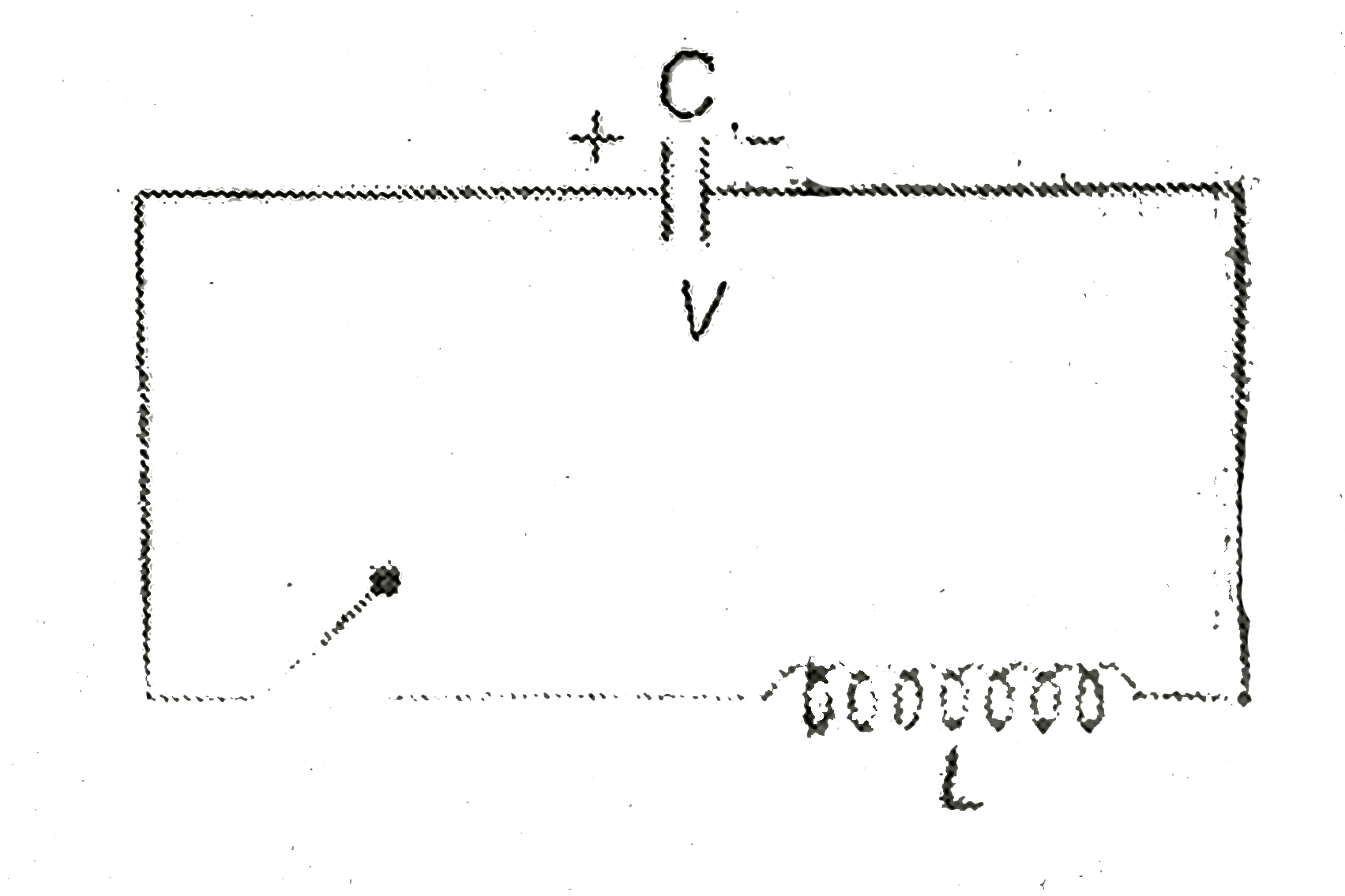A capacitor of capacitance 4μF is fully charged to a potential difference of 12 V and then charging battery is disconnected. Charged capacitor is now connected across an inductor of self-inductance of 1.2 mH. The current in the circuit at a time when the potential difference across the capacitor is 6 V is
0.3 A
0.6 A
0.9 A
1.2 A
The correct Answer is:B
To solve the problem step-by-step, we need to find the current in the circuit when the potential difference across the capacitor is 6 V. Here’s how we can do that:
Step 1: Calculate the initial and final energy in the capacitor
The energy stored in a capacitor is given by the formula:
U=12CV2
- Initial energy when the capacitor is fully charged (V1 = 12 V):
U1=12×4×10−6F×(12V)2
U1=12×4×10−6×144=288×10−6J=2.88×10−4J
- Final energy when the potential difference across the capacitor is 6 V (V2 = 6 V):
U2=12×4×10−6F×(6V)2
U2=12×4×10−6×36=72×10−6J=7.2×10−5J
Step 2: Calculate the change in energy of the capacitor
The change in energy (ΔU) as the capacitor discharges from 12 V to 6 V is:
ΔU=U1−U2
ΔU=2.88×10−4J−7.2×10−5J=2.16×10−4J
Step 3: Relate the change in energy to the energy stored in the inductor
The energy stored in the inductor (U_L) is given by:
UL=12LI2
where L is the inductance and I is the current.
Setting the change in energy equal to the energy stored in the inductor:
ΔU=UL
2.16×10−4=12×1.2×10−3×I2
Step 4: Solve for the current I
Rearranging the equation gives:
I2=2×2.16×10−41.2×10−3
I2=4.32×10−41.2×10−3=0.36
I=√0.36=0.6A
Final Answer
The current in the circuit when the potential difference across the capacitor is 6 V is:
I=0.6A
The energy stored in a capacitor is given by the formula:
U=12CV2
U1=12×4×10−6F×(12V)2
U1=12×4×10−6×144=288×10−6J=2.88×10−4J
U2=12×4×10−6F×(6V)2
U2=12×4×10−6×36=72×10−6J=7.2×10−5J
The change in energy (ΔU) as the capacitor discharges from 12 V to 6 V is:
ΔU=U1−U2
ΔU=2.88×10−4J−7.2×10−5J=2.16×10−4J
The energy stored in the inductor (U_L) is given by:
UL=12LI2
where L is the inductance and I is the current.
ΔU=UL
2.16×10−4=12×1.2×10−3×I2
Rearranging the equation gives:
I2=2×2.16×10−41.2×10−3
I2=4.32×10−41.2×10−3=0.36
I=√0.36=0.6A
The current in the circuit when the potential difference across the capacitor is 6 V is:
I=0.6A
Topper's Solved these Questions
- BOOK - MODERN PUBLICATIONCHAPTER - ELECTROMAGNETIC INDUCTIONEXERCISE - COMPETITION FILE (MULTIPLE CHOICE QUESTIONS) (AIPMT/NEET & Other State Boards for Medical Entrance)8videos
ELECTROMAGNETIC INDUCTION
- BOOK - MODERN PUBLICATIONCHAPTER - ELECTROMAGNETIC INDUCTIONEXERCISE - COMPETITION FILE (MULTIPLE CHOICE QUESTIONS) (JEE (Main) & Other State Boards for Engineering Entrance)38videos
ELECTROMAGNETIC INDUCTION
- BOOK - MODERN PUBLICATIONCHAPTER - ELECTROMAGNETIC INDUCTIONEXERCISE - REVISION EXERCISE (Numerical Problems)16videos
ELECTROMAGNETIC INDUCTION
- BOOK - MODERN PUBLICATIONCHAPTER - ELECTRIC CHARGES AND FIELDS EXERCISE - Chapter Practice Test15videos
ELECTRIC CHARGES AND FIELDS
- BOOK - MODERN PUBLICATIONCHAPTER - ELECTROMAGNETIC WAVESEXERCISE - CHAPTER PRACTICE TEST14videos
ELECTROMAGNETIC WAVES
Similar Questions
A capacitor of capacity 2μF is charged to a potential difference of 12V. It is then connected across an inductor of inductance 6μH. What is the current (in A) in the circuit at a time when the potential difference across the capacitor is 6.0V?
View SolutionA capacitor of capacity 2μF is changed to a potential different of 12V . It is then connected across an inductor of inductance 0.6mH What is the current in the circuit at a time when the potential difference across the capacitor is 6.0V ?
View Solution
Knowledge Check
- Question 1 - Select One
An ideal capacitor of capacitance 0.2μF is charged to a potential difference of 10V. The charging battery is than disconnected. The capacitor is then connected to an ideal inductor of self inductance 0.5mH. The current at a time when the potential difference across the capacitor is 5V is :
A0.34AB0.17AC0.25AD0.15A - Question 2 - Select One or More
A capacitor of capacity 2μF is charged to a potential difference of 12V. It is then connected across an inductor of inductance 0.2mH. At an instant when potential difference across the capacitor is 6v
Acurrent in the circuit is 1.04ABmagnetic energy in the magnetic field is 108μJCcurrent in the circuit is 1.04ADangular frequency of the circuit is 5×104rads - Question 3 - Select One or More
A capacitor of capacitnace C is charged to a potential difference V and then disconnected from the battery. Now it is connected to an inductor of inductance L at t=0. Then
 AEnergy stored in capacitor and inductor will be equal at time t=π2√LCBPotential difference across inductor will be V2 at time t=π3√LCCThe rate of increase of energy in magnetic field will be maximum at π4√LCDWhen the potentail difference across the capacitor √(3CL)
AEnergy stored in capacitor and inductor will be equal at time t=π2√LCBPotential difference across inductor will be V2 at time t=π3√LCCThe rate of increase of energy in magnetic field will be maximum at π4√LCDWhen the potentail difference across the capacitor √(3CL)
Find charge on each capacitor and potential difference across each capacitor .
 View Solution
View SolutionA 100pF capacitor is charged to a potential difference of 80.0V and the charging battery is disconnected. The capacitor is then connected in parallel with a second capacitor. If the potential difference across the first capacitor drops to 35.0 V what is the capacitance of this second capacitor?
View SolutionA capacitor of capacitance C is charged to a potential difference V0. The charged battery is disconnected and the capacitor is connected to a capacitor of unknown capacitance Cx. The potential difference across the combination is V. The value of Cx should be
View SolutionA capacitor having capacitance 2 μF is charged to a potential difference of 50 V. it is then diconnected from battery and connected to an inductor of inductance 5 mH. Peak current that flows through the inductor is
View SolutionA 10μF capacitor is charged to a potential difference of 1000V. The terminals of the charged capacitor are disconnected from the power supply and connected to the terminals of an uncharged 6μF capacitor. What is the final potential difference across each capacitor ?
View Solution

